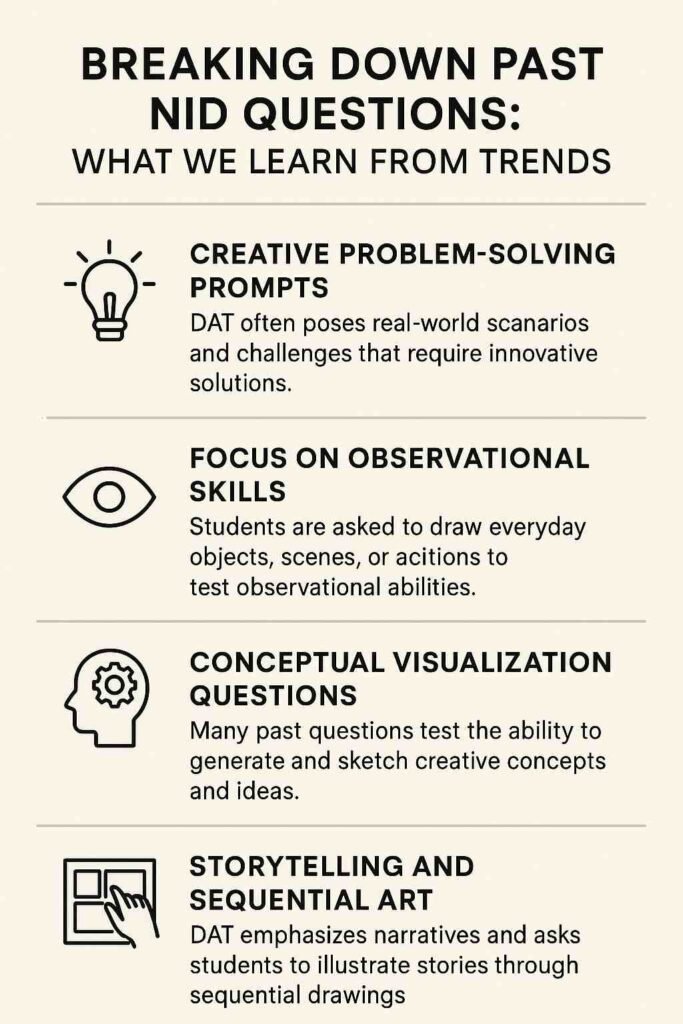
Cracking the NID Design Aptitude Test (DAT) isn’t just about artistic skill—it’s also about understanding how to think like a designer. Over the years, NID has consistently tested specific patterns in problem-solving, visualization, and storytelling. In this blog, we’ll dive deep into past DAT questions to uncover the most recurring trends and techniques that can give you a strategic edge in your preparation.
1. Creative Problem-Solving Prompts
What they are:
These are open-ended challenges that require students to ideate innovative design solutions for real-world situations. Think: “Design a mobile stall for selling fruit in the rain” or “Create a product for elderly users with arthritis.”
How to master it:
- Practice divergent thinking exercises.
- Use mind-mapping for idea generation.
- Learn basic product design principles (ergonomics, sustainability, usability).
- Analyze everyday problems around you and try redesigning the solution.
2. Focus on Observational Skills
What they are:
NID often tests your ability to see—not just look. Questions might ask you to sketch a scene from memory, replicate an arrangement of objects, or illustrate daily activities like a street vendor or people waiting in line.
How to master it:
- Practice sketching objects around you daily.
- Observe lighting, posture, angles, and proportions.
- Visit crowded places and do gesture drawings.
- Learn to draw from different perspectives.
3. Conceptual Visualization Questions
What they are:
These questions ask students to visualize abstract or functional concepts. For example: “Design a logo for a futuristic transport company” or “Visualize the word ‘freedom’ as a graphic.”
How to master it:
- Build your visual vocabulary through visual references.
- Practice converting words into images or symbols.
- Learn logo and icon design basics.
- Use thumbnail sketches to explore multiple ideas quickly.
4. Storytelling and Sequential Art
What they are:
Narrative ability is highly valued. You may be asked to create a 3-4 frame comic strip to show a story (e.g., “A dog’s adventure to find its owner”).
How to master it:
- Study comic strips and storyboards.
- Understand structure: beginning, middle, end.
- Practice facial expressions, gestures, and emotions.
- Work on consistent character drawing.
5. 3D Form Conversion
What they are:
Here, you’re tested on how you understand volume and form. Questions might ask you to convert a 2D object into a 3D form or vice versa.
How to master it:
- Practice drawing cubes, cylinders, and spheres from all angles.
- Use shading to give depth.
- Understand light source and shadows.
- Try drawing from clay models or real objects.
6. Understanding Scale and Proportion
What they are:
These are technical sketching problems, such as showing how a product looks in someone’s hand, or comparing the size of two objects.
How to master it:
- Practice figure drawing.
- Work with grids and comparative measurements.
- Practice drawing interiors and product sketches with a human figure to scale.
7. Redesign Challenges
What they are:
You may be asked to redesign a common object to suit a new purpose—like modifying a bicycle for delivery boys.
How to master it:
- Learn human-centered design thinking.
- Analyze existing products: strengths and weaknesses.
- Study ergonomics and usability.
8. Material and Texture Representation
What they are:
Some questions ask you to represent different surfaces—glass, metal, wood, cloth—using pencil shading or textures.
How to master it:
- Create a texture library in your sketchbook.
- Use different pencil grades and shading styles.
- Focus on light reflections and surface grain.
9. Out-of-the-Box Thinking
What they are:
Expect surprise tasks like: “Draw what would happen if gravity stopped working for one day.” These test your originality and imagination.
How to master it:
- Read books on creativity (e.g., “Steal Like an Artist”).
- Maintain a doodle journal for wacky ideas.
- Don’t censor yourself—be weird, be wild!
10. Quick Ideation under Pressure
What they are:
Many questions are time-bound and require fast thinking, clarity of thought, and crisp execution.
How to master it:
- Practice with a timer: 10 mins per sketch.
- Use thumbnails before full sketches.
- Prioritize clarity over perfection.
Final Thoughts
Trends from past NID DAT papers reveal one thing: originality and clarity matter more than flashy art. NID is looking for thinkers who can sketch their ideas swiftly, smartly, and creatively. Make sure to practice strategically—build a schedule around these techniques, and observe the world like a designer.
With the right preparation and mindset, your NID journey can turn from daunting to delightful!
Want to succeed in your pursuit of a dream career? Join our effective training course for the NID Entrance Test. Call / WhatsApp: +91 9902739994
